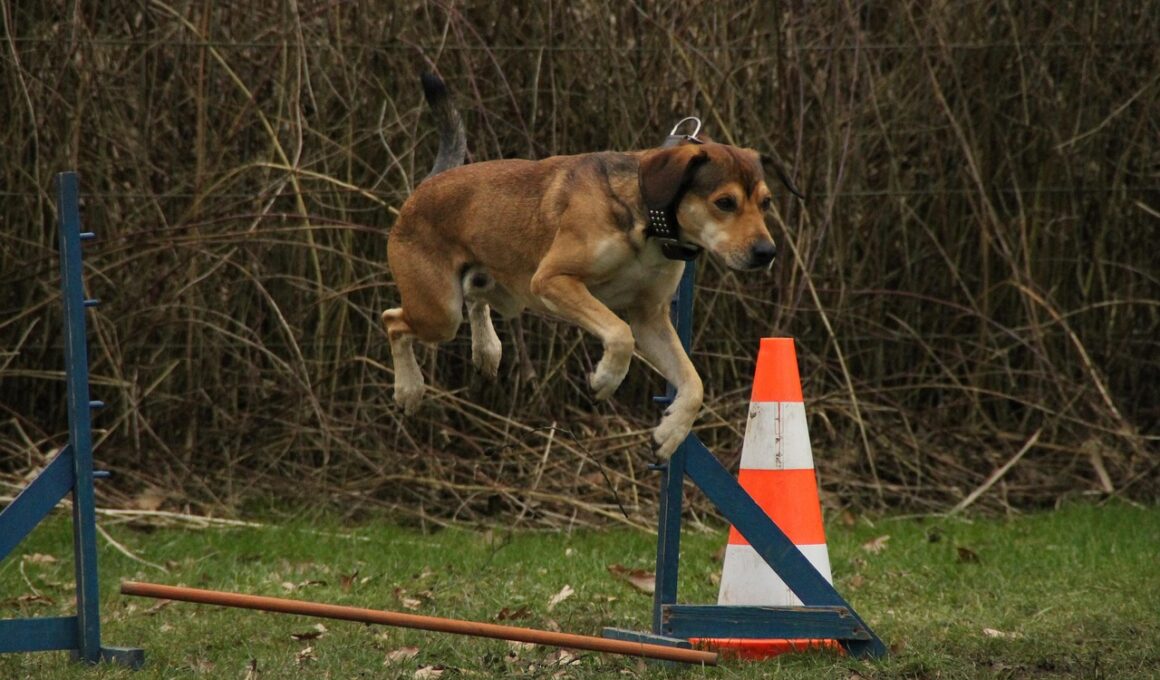How Stretching Improves Your Dog’s Flexibility
Stretching is an essential activity that significantly enhances your dog’s overall flexibility. It aids in maintaining a healthy range of motion in their joints, crucial for active dogs. Many pet owners overlook this important exercise, assuming their dogs will naturally stay limber through daily activities. However, regular stretching can prevent injuries and enhance physical performance in dogs. Stretching also promotes improved circulation, which can aid in quicker recovery after exercise. Additionally, just like humans, dogs can experience stiffness, especially as they age. Stretching exercises can be tailored to fit the specific needs of your dog based on their age, breed, and activity level. It’s essential to incorporate gentle stretches into your dog’s routine, focusing on their legs, back, and neck. You can even create a fun pre-exercise ritual that includes stretches to get your dog excited about the activities that will follow. This positive reinforcement may also strengthen the bond between you and your pet. In summary, regular stretching isn’t just beneficial but is essential in planning a holistic fitness regimen for your dog.
Beyond improving flexibility, stretching significantly enhances your dog’s balance and coordination. These aspects of physical health are critical, especially in active dogs involved in sports or those who love agility activities. A well-stretched dog is better equipped to navigate obstacles and maintain stability during high-energy play. Moreover, stretching helps to prepare the muscles for strenuous exercise, reducing the risk of muscle strains and overheating during outdoor activities. You can utilize versatile stretching methods such as dynamic stretching before play and static stretching afterward. This approach helps to ensure that your dog’s muscles are both warmed up and cooled down properly. Furthermore, developing a consistent stretching routine can also assist in meeting your pet’s physical needs. Dogs may be less prone to fatigue or soreness after exercise, leading to prolonged enjoyment in playtime. It also helps to enhance their general mood and eagerness to engage in activities. As a dog owner, taking the time to stretch with your dog encourages a regular schedule of activity together. Always ensure that the stretches are comfortable for your pet, as well-being during this process is paramount.
The Positive Effects of Stretching
In addition to increasing flexibility and balance, stretching can be beneficial for your dog’s mental well-being as well. Engaging in stretches can be a calming activity for both of you. It provides an opportunity for relaxation and connection, which helps release endorphins, known as the body’s natural painkillers. These hormones help elevate your dog’s mood while relieving stress, making stretching a vital aspect of not just physical fitness but mental agility too. For senior dogs or those with previous injuries, stretching may alleviate discomfort more effectively than just resting. The activity can also provide a sense of routine and predictability, which is helpful for pets with anxiety or behavioral issues. By incorporating stretching into their daily schedule, you can ensure that your dog feels secure and cared for. Additionally, you may notice an improvement in their respiration and overall cardiovascular health due to the increased blood flow from stretching. Regular practice of stretching can help your dog remain active and engaged throughout their life, ultimately enhancing both quality of life and longevity for your beloved companion.
Finding the right stretches for your dog is vital, as not all stretches are suited for every dog. It is imperative to know your dog’s limitations and tailor the exercises specifically to their needs. Some popular effective stretches include the neck stretch, shoulder stretch, and hamstring stretch. Incorporating these into your pre- and post-exercise routines can provide great benefits in terms of flexibility, posture, and mobility. Also, certain breeds may have additional considerations regarding flexibility, especially those prone to joint issues. By consulting with a veterinarian, you can personalize a stretching routine that meets your dog’s unique requirements. They might recommend specific exercises that can cater to your dog’s age, weight, and health status. Establishing a comfortable setting is crucial for conducting stretches. Ensure that the environment is calm and inviting, free from distractions. This will facilitate your dog feeling relaxed and more responsive to the stretching activity. You could use treats to encourage your dog to follow you during the stretches, making it an enjoyable experience. Remember to always keep your stretching sessions short and fun!
Understanding Your Dog’s Needs
Monitoring your dog’s response to stretching is critical for ensuring their safety and comfort. Every dog is different; some might love stretching, while others may resist it. Pay attention to the signals your dog gives during the exercise. If they whine, pull away, or seem uncomfortable while you are stretching them, you should stop. Overstretching can lead to injuries, compromising your efforts to improve flexibility. Also, consider the appropriate time to implement stretching. After your dog has warmed up with light activity, is the ideal time for performing stretches. Stretching cold muscles can lead to strains or soreness. It’s also essential to build trust with your dog throughout this process. More exercise means increased vigor, and high-energy dogs might initially be reluctant to sit still for stretches; however, remaining patient and consistent will reap benefits. As your dog becomes accustomed to stretching, they may even start to enjoy these gentle movements. Celebrating their progress through positive reinforcement will motivate them to engage regularly in stretching sessions, ultimately leading to enhanced mobility and a healthier lifestyle.
Incorporating flexibility exercises within a broader exercise routine also enhances your dog’s fitness. Mixing stretching with various forms of exercise can keep your pet engaged while promoting overall health. Activities such as walking, hiking, or playing fetch can complement stretching sessions and contribute to a balanced fitness regime. Variety prevents boredom in exercising dogs while providing more avenues to promote their well-being. You may also want to engage a professional trainer or canine physical therapist for additional guidance. They can provide specialized techniques or strategies tailored to your dog’s individual needs, which may include teaching you advanced stretching techniques. It is also crucial for dog owners to remain actively involved in their pets’ activities to recognize any signs of strain or discomfort. Conclusively, establishing a stretching routine is a multi-faceted approach to enhancing your dog’s flexibility, mobility, and overall health. Moreover, it solidifies your role as a proactive pet parent focusing on your dog’s physical and emotional wellness. As you incorporate these strategies, you will likely witness a positive transformation in your dog’s fitness and energy levels.
Conclusion: The Importance of Dog Stretching
In conclusion, stretching plays a critical role in maintaining and improving your dog’s flexibility and overall health. Incorporating a personalized stretching routine into your dog’s daily activities can lead to multiple long-term benefits. Enhancing flexibility, balance, and coordination reduces injury risks and promotes quicker recovery after exertion. Additionally, it can bring positive mental health benefits for your pet, fostering a strong bond between you and your dog. Regular stretching routines tailored to your dog’s unique needs and preferences will encourage physical activity and improve overall quality of life. Not only does stretching benefit older dogs, but it is also critical for younger, more active breeds. Thus, making stretching an essential aspect of your dog’s activity regimen can ensure they remain active well into their golden years. They will appreciate the attention and care you are providing, leading to a healthier, happier pet. As you engage in these stretching exercises, you will notice improvements in their movement and behavior, reinforcing the importance of regular physical activity. Invest time in your dog’s stretching, and you will surely see the reward in their health and happiness.
Encourage all dog owners to prioritize stretching as a part of their dog’s exercise routine. With the advantages stretching brings. You can enrich your dog’s life significantly and promote both physical and emotional well-being. By prioritizing flexibility exercises early on, you set the foundation for a lifetime of health, endurance, and comfort. Stretching becomes a simple yet impactful activity that can make a great difference for your dog, helping them thrive in every stage of life. This thoughtful approach to your dog’s fitness regime is paramount for promoting longevity and vitality in their daily endeavors.


